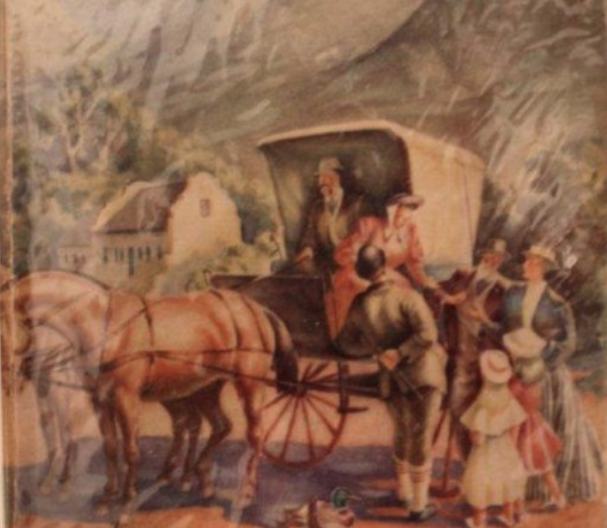Victor Harley, a Malmesbury-based fine knife craftsman and artist, recently gave me a copy of an interesting excerpt from a book titled “In the Land of Afternoon” which was written by Lawrence Green and published in 1949.
Although the racial terminology of the times doesn’t sit well with one, it is nevertheless fascinating to learn the early/mid-20th century history of the discovery and commercialisation of Rooibos, and how Rooibos was viewed and understood at the time. It’s got to be said that rooibos cultivation and processing techniques have not progressed very much in the last 63 years!
It’s also interesting for me to re-confirm that Klipopmekaar is truly located at the original source (a mere five kilometres away as the crow flies from our South Western border) of the rooibos farming industry.
From the Chapter titled “Old Dutch Medicines”…
“If my five acres were in the Cedarberg Mountains I would grow bush tea and stand a chance of selling the crop for 1000 pounds a year. I was fascinated by what I saw and heard of bush tea in the Cedarberg.
Bush tea is often confused with buchu. It is, of course, an entirely different plant – a legume. You hear it called rooibos, heuning tee, stekel tee, boer tee; there are a number of varieties. The Cedarberg species is known to scientists as “cyclopia vogelii harv.” It is mentioned in the Bible (Ecclesiastes: Chapter 24, Verse 15): “I give a sweet smell like cinnamon and aspalathus.” Bush tea belongs to the genus Aspalathus.
The main virtue of bush tea lies in the fact that you can stew it, take it in large quantities and suffer no ill effects. It contains no tannin, no alkaloids. Thus it does not upset people suffering from heart trouble, dyspepsia or insomnia. Make it as strong as you like. Try it iced with a slice of lemon. Drink gallons of hot bush tea with impunity. It increases the appetite, and some declare that it relieves chronic catarrh and asthma.
Dr Peter Le Fras Nortier is the man behind the bush tea boom in the Clanwilliam district. This country doctor, born and brought up on a farm, is a lover of the soil. One of the first Rhodes scholars, he studies medicine at Pembroke College, Oxford, and at Liverpool. Late in 1917, after war service, he set up in practice in Clanwilliam.
A few miles outside the town Dr. Nortier started an experimental farm. He grew mangos and avocados on the banks of the Olifant’s river, and developed a seedless orange that became famous. There I met him in his cool rondavel; a friendly scientific man with a pearl-buttoned waistcoat and corduroy trousers, a man equally familiar with stethoscopes and spades.
Nearly twenty years ago Dr Nortier decided to find out whether the wild bush tea could be cultivated. Bush tea had always found a market in the Cape. One of my books, “Everyday Life in the Cape Colony”. Published in 1902, remarks: “In most of the stores bush tea can be bought. It costs sixpence a pound, looks like the clippings of a privet hedge, including the twigs, and is said to be a tonic.” The demand was increasing in 1930, and all the bush tea was being collected more or less painfully by the same bands of coloured people who brought in the buchu.
Dr Nortier immediately encountered a seed problem. He begged the farmers to bring him seed, but no one collected it. When he offered to pay for it an aged Hottentot woman came again and again, receiving a shilling for each match-box filled with seed. Evidently she had a large supply, and at last the doctor learnt the secret.
The ants of the district collect rooibos seeds and store them underground. The old woman had been robbing the ants. Little did she imagine that within ten years the price of the match-box of seed would rise from a shilling to 5 pounds; the most expensive vegetable seed in the world at 80 pounds a pound. The scarcity is caused by the dispersal of the seeds as soon as the pods crack. Bush tea grows in such lonely places that it is hard to find and hard to be there at the right moment for seed collecting.
Dr Nortier planted the seeds on Klein Kliphuis farm, six miles up the Pakhuis Pass. The farm is owned by Mr W. T. Riordan, a retired magistrate; and the terraced garden close to the road, with its oranges and strawberries, is one of the sights of the district. From the height of two thousand feet you have a view of the sweltering Olifant’s river valley without feeling the heat.
At first the tough seeds would not germinate. Dr Nortier solved this problem by scarifying the seeds. That gave results that were eighty percent successful. The next snag came when the tiny bushes were transplanted. This process must coincide with the rains; you must plant after heavy rain at a time when more rain is due. The farmer who secures a fifty percent “strike” regards himself as lucky.
The seed is sown in January and the seedlings are transplanted when about one foot in height in June. Under ordinary field conditions there should be a small crop in the second year, a reasonable crop in the third, and large crops in the fourth and fifth years. The life of the cultivated plant is about seven years. Wild plants grow much longer.
Mr Riordan settled on his farm in 1943, and when I visited him four years later he had placed four morgen of his nine hundred morgen under bush tea. The income from this small area was so satisfactory that Mr Riordan’s son (a mining engineer in Johannesburg) abandoned gold in favour of the more profitable bush tea.
Although the whole process is still in the experimental stage, one farm in the Clanwilliam area has already yielded an 8000 pound crop. The crop is collected in February and each bush should yield, on average, about one pound of dried tea. Mr Riordan secured 10 lbs. from one huge bush. It grew to six feet in height, but although he and his son studied this monster carefully, they never discovered the reason.
From the point of view of scientific cultivation bush tea is still in its infancy. No irrigation is necessary. Nothing yet is known about fertilization possibilities. The seed grows in poor sandy soil and flourishes where even rye will not grow. Even the botanical classification of the different bush teas has never been done properly.
When picked the green tea is put through a chaff-cutting machine, then bruised with wooden mallets, sprinkled with water and left in heaps to ferment. Next day it is sun-dried on a cement floor, when it loses nearly half its weight. The Cedarberg tea flower is small and yellow and the leaves are red when cured – the most familiar popular rooibos of the grocer’s shop. Another variety gives a black leaf, which appears to have a future from a blending point of view. Probably the most delicate flavour of all is provided by a bush tea with a small red flower, found only on the highest Cedarberg peaks.
Mr Riordan bought his farm “for a song” as he says, in 1918 when he was stationed at Clanwilliam as magistrate’s clerk. For years a tenant paid 1 pound a month for the property which is now yielding a comfortable income.
Buck, hares, ants and borer worm are the enemies of the bush tea plant. Mr Riordan considers that the hare does the most damage, and is fencing against it. He has devised a method of growing wheat between the rows of tea as a unique windbreak.
At one time it looked as though bush tea would be exterminated in the Cedarberg, for goats were grazing on it – and goats have eradicated many a useful plant in many parts of the world. Fortunately the wild bush tea survives mountain fires; the stump sprouts again. Cultivated bush tea, on the other hand, is killed by fire.
Bush tea is popular in the fashionable cafes of the United States. They call it “Kaffir tea” over there; it is sold at seven shillings and sixpence a pound, and a cup in a café costs two or three shillings.
Some people find the “wild” flavour of bush tea a little startling. The people who grow it know how to brew it, and I am glad that I had my first cup of bush tea in the inspiring atmosphere of the Cedarberg mountains. At the end of a day’s hunting it seemed a magnificent drink.
This is the Cedarberg way with bush tea. Boil the water and pour one cup over the leaves. Let it stand for several minutes, drain off the water, then fill the pot with boiling water and allow it to infuse for fifteen minutes, Put it on the stove and bring it to the boil as often as you like. You may blend bush tea with China or Ceylon if you wish, but this is purely an economy measure in the cities. The bush tea connoisseur, way up in the mountains, will not tolerate a blend.

